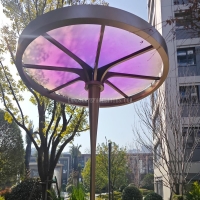Welcome to the website for landscape facilities products and knowledge.
How do landscape bar counters handle thermal expansion and contraction due to temperature fluctuations?
Landscape bar counters, often serving as stunning centerpieces in both indoor and outdoor settings, face significant challenges from temperature fluctuations. These structural elements expand when heated and contract when cooled, creating potential risks like cracking, warping, or joint failure. To handle this inherent material behavior, manufacturers and designers implement several sophisticated engineering strategies.
Material selection is the first critical line of defense. Engineered quartz, certain grades of granite, and porcelain slabs are popular for their lower thermal expansion coefficients compared to materials like marble or solid surface. For outdoor counters, stainless steel with protective coatings is chosen for its predictable and uniform response to heat. The core principle is using materials that naturally exhibit minimal dimensional change with temperature swings.
The most vital technical solution is the incorporation of expansion joints. These are intentional, strategic gaps filled with a flexible sealant (like silicone or polysulfide) placed at calculated intervals along the counter's length. These joints are not flaws; they are essential design features. They act as relief points, absorbing the stress created by the counter's movement, preventing that force from causing cracks elsewhere. The placement and width of these joints are carefully calculated based on the material's properties and the expected temperature range.
Installation techniques are equally crucial. Counters are never rigidly fixed at all points. A system of flexible clips or brackets is used to secure the countertop to the base cabinetry or structure. This method allows the slab to expand and contract freely horizontally while remaining vertically stable. For long, continuous runs, structural supports are designed to permit slight movement without compromising stability.
Furthermore, the substructure must be designed for compatibility. A rigid, immobile base framework would resist the counter's movement, leading to failure. Therefore, the foundation is built to be robust yet accommodating, often using materials that move in concert with the top, such as treated steel or aluminum frameworks.
In conclusion, the integrity of a landscape bar counter under thermal stress is not left to chance. It is preserved through a deliberate combination of intelligent material choice, the precise implementation of expansion joints, and a flexible installation system. This multi-faceted approach ensures these beautiful and functional structures remain durable and crack-free for years, regardless of the surrounding temperature variations.
Related search:

Recommendation
Metal frame with gradient color acrylic combined with high-end shading landscape facilities